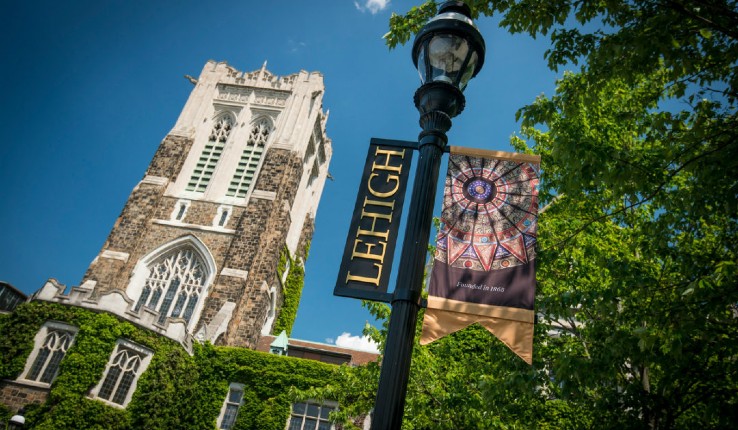As climate change continues to pose an increasingly dire threat to the environment, public health, infrastructure, agriculture and the economy, Lehigh is taking action to further its commitment to environmental sustainability.
As part of its Sustainability Strategic Plan 2030 which was released in October, Lehigh has begun the process of creating a Climate Action Strategy. This strategy will provide a detailed framework and serve as a comprehensive roadmap for measuring, planning and reducing greenhouse gas emissions. It will help the university understand where, and how, to achieve emissions reductions.
By striving for carbon neutrality with an approach that is realistic for Lehigh, the university will not only align with peer higher education institutions but also support the City of Bethlehem’s Climate Action Plan, which will be published by the city in the first quarter of 2021.
“Climate change and its many consequences present a critical threat to the world today,” said President John D. Simon ’19P. “At Lehigh, we are committed to doing our part to address one of the greatest challenges of our time. This Climate Action Strategy will provide a clear, realistic and cost-effective roadmap for achieving the university’s climate action goals.”
Lehigh's Climate Action Strategy will outline a set of energy-efficiency projects that will reduce emissions and reduce operating costs, a “win-win approach,” according to Katharine Targett Gross, Lehigh's sustainability officer. In addition, she said the strategy will develop emissions reduction pathway options to establish a carbon neutrality goal.
“One of the university’s visions is a commitment to social, environmental and economic sustainability,” said Provost Nathan Urban. “Creating this Climate Action Strategy will advance solutions that support that vision through sustainable change in operations.”
The first step of Lehigh’s Climate Action Strategy will include the creation of an Energy Capital Investment Plan and wedge analysis to identify energy-efficiency projects that will have the maximum impact, prioritized by largest cost savings and reduction in greenhouse gas emissions.
“The Climate Action Strategy is not only another step toward fully integrating sustainability into the institutional ethos at Lehigh, but it will also benefit the university from a financial standpoint,” said Patricia A. Johnson, vice president for finance and administration.
Based on the Energy Capital Investment Plan, along with a review of legacy inventories reports and the energy project financing analysis, several greenhouse gas reduction pathways will be developed.
“Establishing this Climate Action Strategy is key to all our planning initiatives, as we look to make decisions for the future of Lehigh’s campus that are sustainable from an environmental, operational, and financial perspective,” said Brent Stringfellow, associate vice president of facilities and university architect.
The proposed six- to eight-month project to create the Climate Action Strategy began in September with building energy audits and analyses conducted by Stone House Group, the Lehigh Industrial Assessment Center and Energy Systems Engineering. The audits and analyses will be completed by December.
Lehigh’s Climate Action Strategy will also uphold the university’s 2009 Climate Commitment, in which Lehigh vowed to create institutional policies and procedures to protect and improve the environment, and its commitment to We Are Still In, a joint declaration of support started in 2017 for climate action and signed by nearly 4,000 leaders, including CEOs, mayors, governors and college presidents.
To assist with the development of the strategy, the Office of Sustainability, in collaboration with LU Facilities, has selected two consulting firms: Stone House Group, which is working on the technical aspects of the strategy, and Trust, which is providing programmatic support, campus engagement and experiential learning support.
"This strategy is an opportunity for Lehigh to truly lead and energize the campus community around climate issues," Targett Gross said. "Leadership on climate issues is not only related to our institutional environmental footprint, but it is also becoming increasingly important to current students, prospective students and alumni."
The strategy is also providing experiential learning opportunities — using the campus as a living laboratory — for Lehigh students, both during its development and after it is adopted and implemented. Lehigh’s Industrial Assessment Center will be directly involved in the building energy audits, and Lehigh’s Energy Systems Engineering program will be involved in analyzing data from the audits. Once the project is completed, additional experiential learning opportunities will be identified.
"It is quite evident that Pennsylvania broadly, and the Lehigh Valley specifically, is already experiencing the effects of climate change and will continue to do so,” Targett Gross said. “It is critical for Lehigh to do its part as a climate leader.”
A number of studies have been published citing the potential impacts of climate change in the region:
- Projections from the 2020 April Pennsylvania Climate Impacts Assessment Update, which is produced by the Pennsylvania Department of Environmental Protection, show that average rainfall and extreme precipitation will increase 8% to 12%, particularly in the winter and spring, while the state’s average temperature will rise at least 2.7 degrees Fahrenheit.
- According to the National Oceanic and Atmospheric Administration (NOAA), which tracked precipitation and temperature rates across the nation from July 2018 to June 2019, Pennsylvania experienced its “record wettest year” and temperatures “much above average” during this time period.
- Pennsylvania’s Eastern Central Mountains climate division, which includes the Lehigh Valley, had a 30-year temperature increase of 2.07 degrees Fahrenheit, the highest of any of the state’s 10 climate divisions, according to an Associated Press statistical analysis of 30 years of weather, ice, fire, ocean, biological and other data.
- A study published in 2019 in Nature Communications predicts that in 60 years, Allentown will have a climate similar to that of present day Arkansas: wetter, warmer winters with less snow and more rain, and significantly drier summers.





